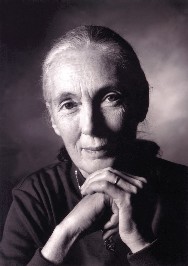
In the summer of 1960, 26-year-old Jane Goodall arrived on the shore of Lake Tanganyika in East Africa to study wild chimpanzees at the request of the famed anthropologist and paleontologist Dr. Louis Leakey. Leakey hoped that Goodall's observations would serve as a window into the evolutionary past of humans. Little did he know that Goodall's scientific discoveries would lay the foundation for future primate studies.
Through books and documentaries, we have shadowed Dr. Goodall through the forest of Gombe and shared many special moments, including the very first time she watched David Greybeard fashion a small leafy twig to fetch termites from a hole in the ground. The simple action dispelled the long-held belief that only man could make and use a tool.
In 1977, she co-founded the Jane Goodall Institute for Wildlife Research, Education and Conservation. The institute advances the power of individuals to improve the environment. Goodall's Roots & Shoots, a program for youth from preschool through the university, has inspired more than 4,000 groups of children, teenagers, and young adults in 70 countries to actively care for animals and the environment, as well as, their communities.
Goodall returned to England after her first research study and earned her Ph.D. in ethology from Cambridge University. She has received countless awards including the Kyoto Prize, the Encyclopedia Britannica Award, the Animal Welfare Institute's Albert Schweitzer Award, and the National Geographic Society's Hubbard Medal. She currently serves as a National Geographic Society Explorer in Residence and as the United Nations "Messenger of Peace."
At 23, Dr. Goodall moved to Kenya to work for paleontologist Dr. Louis Leakey, who helped arrange for her chimpanzee research.
Dr. Goodall traveled to Africa to study the behavior of chimpanzees, starting the longest field study of animal species in their natural surroundings.
Observing a chimp use a branch to find food, Dr. Goodall was able to prove that humans were not the only species to make and use tools.
Dr. Goodall founded the Jane Goodall Institute to promote conservation of primate habitats, awareness, and research.
Information as of April 2003

